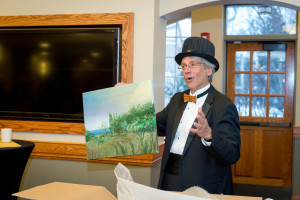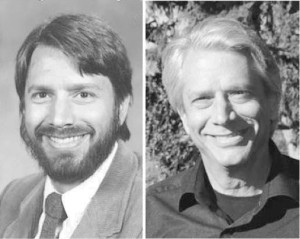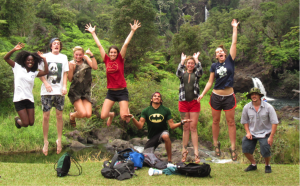Conjure an image of a university professor, and what comes to mind? Eccentricities in clothing and jackets with elbow patches? Cramped, stuffy, offices, overflowing with dusty books, papers, manuscripts and memorabilia from travels around the world?
While Professor Dan Binkley may not fit that mold perfectly, his career is a model for a university professor. “I never saw him in one of those tweed jackets with the elbow patches,” said colleague Professor Tom Stohlgren, “but Dan is my image of a professor.”

Binkley celebrates his retirement this semester from his positions as professor in the Department of Ecosystem Science and Sustainability, and senior researcher in the Natural Resource Ecology Laboratory.
Binkley came to CSU and the Warner College of Natural Resources as an associate professor of Forest Ecology in 1987, quickly making impacts on the college’s capacities around forest ecosystem dynamics, forest soils, ecological restoration and teaching evidence-based approaches to solving problems.
In 1994, he served as the first director of CSU’s Graduate Degree Program in Ecology, and was named the program’s Distinguished Ecologist in 2007. The program was born out of CSU’s widespread, growing expertise in ecology that spanned across various departments around campus.
“One of the things that’s made CSU a great place to invest a career is that there are almost no barriers to collaborating across departments and colleges,” Binkley said. “GDPE is one of the strongest indicators of how that could come together to benefit students.”
In 2004, he established the Colorado Forest Restoration Institute in the Warner College, and served as director until 2008. Today, the program boasts seven full-time staff, and conducts analyses of forest restoration and stewardship projects on over 200,000 acres of forests in Colorado.
Since 2007, he’s been the co-editor of the scientific journal Forest Ecology and Management, a journal Binkley’s colleagues say is much stronger as a result of his involvement.

Along with program administration and research, Binkley always remained committed to students and teaching. “My favorite part of being a professor has always been the student interactions,” Binkley said. “Seeing them grow and mature as scientists is very special. Reading publications after they’ve moved on, and knowing where they started, always makes me proud.”
“Many of Dan’s students, particularly his international students, have gone on to be leaders in their own right in their fields,” added fellow NREL research scientist Mike Ryan.
Throughout his time at CSU, Binkley maintained a robust research program, leading to the publication of several books and hundreds of journal articles, as well as collaborative projects with diverse stakeholders in Colorado and around the world.
Bringing diverse stakeholders together
Binkley’s abilities to bridge people’s differences, as well as his passion for science and evidence-based approaches served him well in his career. “Science has a lot in common with art,” Binkley said. “Artists are driven by capturing what they perceive as truth, and putting it into the medium they use. Scientists are driven by exactly the same thing. The appreciation of science is when that work is taken and applied in the field.”
“Dan’s always had a unique ability to bring together stakeholders with diverse views, and help them find common ground,” recalled Professor Bill Romme, who worked with Binkley on a wide array of projects. One in particular that jumped to Romme’s mind was an effort to engage citizens in management planning for the Uncompaghre National Forest. Binkley and Romme carried out a citizen science program, allowing local residents to take scientific measurements that gave them an understanding of the historic structure of the forest, a method Binkley coined “forensic forestry.”
According to Romme, the work was so successful that when the Forest Service published the area’s management plan there was no public opposition to the efforts, a response USFS rarely sees with management planning.

Another example of Binkley’s ease with collaboration was taking part in an acid rain workshop in Sweden, an opportunity which led to a decades-long relationship with the country’s University of Agricultural Sciences.
“The Swedes had a tradition of being very courteous to one another, and I was invited by a colleague who was concerned that a scientific discussion maybe needed a little bit of a kick in the pants from somebody who wasn’t so courteous,” Binkley said. “So even though he hadn’t met me, he took a gamble and invited me to come over and be the brash American who could say things frankly.”
The relationship and lasting collaborations culminated in Binkley spending a semester at the Swedish University of Agricultural Sciences as the Royal Academy of Forestry and Agriculture’s Wallenberg Professor and receiving an honorary doctorate from the university.
Binkley’s work and techniques made an impact on some of the most globally significant forestry questions of our time. One such question, still unanswered, is why trees grow rapidly until forest canopies fully develop, and then see reductions in growth as leaves shade out the forest floor. For those sorts of questions, Binkley said his favorite forest systems to study are eucalyptus plantations in Brazil.
“With these you see a fully developed stand of trees within six years,” Binkley noted. “In Colorado you’d need 100 years.”
The rapid development of stands allows for a relatively quick turnaround in data collection, and an ability to start experimenting with treatments rapidly. Ryan lauded Binkley’s work in Brazil for its novelty.
“One of Dan’s clever ideas was to set up just two plots, a control and a treatment plot, right next to one another, rather than a whole series of plots in different spots with different treatments.” Ryan explained. This new approach allowed managers to see changes across a landscape, and the technique has been replicated thousands of times in Brazil. It is now being adopted by mangers in Argentina, according to Ryan.
These kinds of practical approaches are a hallmark of Binkley’s career and, in particular, his outreach with practitioners. “Any manager can be a pocket scientist,” Binkley explained. “That’s not a rocket scientist with special training and a billion dollars, but a pocket scientist, where all you need is a GPS unit and a camera.”
In this way managers can take a small part of a larger forest plot, adjust the treatment, and then just go back out every couple years to take photos. Then they have a real visual representation of the changes in the forest to discuss with colleagues. “Humans are visual creatures and learn about things by seeing them much better than reading dry prose in academic journals,” Binkley said.
Retirement?
While Binkley will be leaving his academic and research appointments at CSU, he shows little sign of slowing down.
He’ll soon be headed to Australia to be a visiting professor at the University of Sydney to collaborate on a project investigating how trees cope in ancient soils that are low in nutrients.
Then, in 2017, it’s on to Semester at Sea, where Binkley and his wife will participate in one of CSU’s first voyages as a professor and the ship’s doctor, respectively. Binkley also plans to spend time on his tree farm in Hawaii, growing trees and watching the ocean from the deck of his house with his feet up.
Binkley’s colleagues will always remember his good nature and humor, his effectiveness and strength as an administrator, and his passion for science and teaching.
“After working with Dan a bit you came to realize that while he takes science and teaching very seriously, he didn’t take himself too seriously,” said Stohlgren.
“The best parts about working with Dan were his enthusiasm, his ideas and his focus on getting things done,” said Ryan. “A lot of times on projects Dan was the border collie, keeping everyone together and focused on getting the job done.”